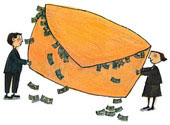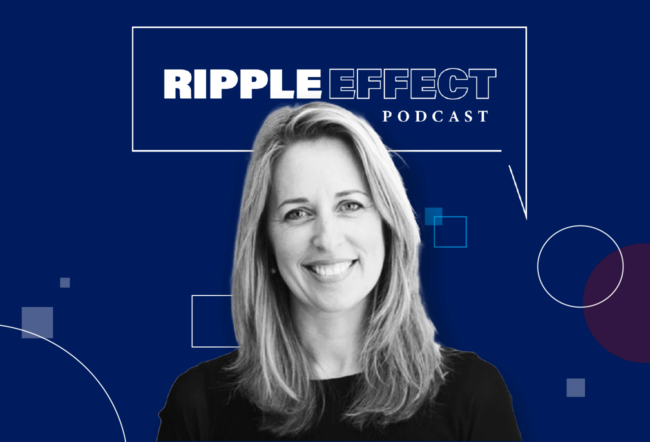Compensation for American CEOs has soared over the past decade, far exceeding inflation and wage gains of ordinary workers — and leading critics to charge that self-serving insiders have tilted the playing field at shareholders’ expense.
In response, the Securities and Exchange Commission on January 17 took the first step toward adopting rules to better show shareholders how much their top executives and directors are paid. The changes, pushed by the commission’s new chairman, Christopher Cox, would for the first time require companies to clearly report a total compensation figure for each of the top five executives and all directors. Disclosure would include the values of stock options, retirement and severance plans and perks worth over $10,000, all of which are difficult or impossible to assess currently. A final vote is expected in the spring after a public-comment period, and most observers expect the rules to be adopted.
Will that drive executive pay down?
Probably not, say several Wharton professors, arguing that executive pay is not necessarily as excessive as the most extreme cases suggest. Still, all agreed that more complete, clearer disclosure would improve the system. “When people are forced to undress in public, they pay attention to their figures,” jokes William C. Tyson, professor of legal studies and ethics at Wharton.
Tyson, an expert on the SEC, says he expects the proposals to be approved. “I don’t think that there are going to be too many negative comments submitted about this, because it’s just requiring more disclosure.” But he doubts the changes would dramatically affect executive pay, which is governed by many factors. “I don’t see the changes as that significant. Companies now assign outside directors to compensation committees and they are generally setting pay rates at levels governed by supply and demand,” Tyson notes. “In principle, there are things in place that should prevent unreasonable salaries, but there are always market imperfections.” Better disclosure should help remedy those, he adds.
According to Wharton management professor Martin Conyon, “People have been critical of executive compensation for a number of years, and will always be critical of executive compensation.” Similar public outrage over accelerated executive pay led to disclosure reforms in 1992 as well.
“Throughout the 1990s, the level of executive compensation increased dramatically, especially in S&P 500 firms,” Conyon notes. Indeed, a study by Wharton accounting professors John E. Core and Wayne Guay and Randall S. Thomas of Vanderbilt University shows that median annual pay for S&P 500 CEOs rose from $1.98 million in 1993 to $6.58 million in 2003. Another study, this one by The Corporate Library, a Portland, Maine, nonprofit that advocates better corporate governance, found that the typical CEO’s compensation rose by 15% in 2003 and 30% in 2004 — about 10 times the inflation rate.
And a study by Lucian Bebchuk and Yaniv Grinstein of Harvard found that from 1993 through 2003, executive pay increased to about twice the level that could be explained by factors such as growth in company size and stock performance. In 2003, compensation for top executives equaled 10% of their companies’ annual earnings, compared to 5% percent in 1993, the study reported.
Factoring in Stock Options
Executive compensation is typically a combination of base pay, annual bonus tied somehow to performance, grants of stock, stock options, contributions to a retirement program, and perks, which can include everything from personal use of the corporate jet and limousines, to club memberships and contributions to the executive’s designated charities. Currently, it is extremely hard to determine the total value from corporate filings, which don’t place a value on the stock options or reveal much about pension plans and perks.
It is fairly clear, though, that compensation has been driven upward by greater use of stock options, which give the executive the right to buy company stock at a set price anytime over a number of years, typically 10. Options can soar in value if the stock price rises above the set purchase, or strike, price. “The explosion in the use of stock options in the 1990s cannot be stressed enough,” Conyon says, noting that in the early 1990s, options accounted for about 20% of the typical CEO’s compensation. By 2000, that had grown to 50%.
Current rules require companies to disclose how many options are granted to each top executive, but not to place a value on them. Experts can estimate values, but ordinary shareholders generally cannot, leading the SEC to propose a standard methodology that will reveal the value and make it easier for shareholders to compare companies. The SEC is also now requiring companies to calculate their executive and employee options expenses in figuring earnings. “As stock options became more important, people thought, ‘Hang on a second…. Is the tax and accounting treatment of them appropriate?’ It turned out that folks said, ‘No,’ and it has been changed,” Conyon adds.
While critics say something is wrong when executive pay gains vastly outpace inflation and ordinary Americans’ wage gains, it is not that easy to establish a benchmark for determining whether executive pay is excessive, Conyon notes. Numerous studies have shown that American CEOs make considerably more than their counterparts in other countries — sometimes many times more. But, he points out, the U.S. economy and stock markets have outperformed most foreign ones. “The system here seems to be working.”
Guay does not believe the typical CEO’s pay is excessive. “The egregious pay packages that attract so much attention from the press — of, say, $20 million plus — only apply to a handful of CEOs.” The median CEO in the S&P 1500, composed of the 1500 largest publicly traded companies, “makes about $2.5 million a year.” Most CEOs work 12 hours a day for perhaps 350 days a year, he adds, arguing that many top lawyers, consultants or Wall Street traders and analysts make $2.5 million or more.
“Why has executive pay risen so much in the last 15 years?” Guay asks. “It seems pretty clear that the world has become more complex, global business is essential, technology is moving faster than ever. Highly skilled CEOs are likely in greater demand than ever before.” In addition, today’s CEO faces greater risks from litigation and a tougher regulatory environment. And finally, he says, today’s CEOs are expected, and often required, to keep a large portion of their personal wealth tied up in their companies’ stock and options — as much as 50% to 75% of their net worth.
The idea was to satisfy shareholders’ demands that executives’ interests be aligned with their own. But an executive with so many eggs in one basket faces serious risk of loss if the stock price falls. Hence, he or she will demand more compensation to offset the risk.
In 2003, for instance, the median S&P 500 CEO had an annual pay package worth $6.58 million, but also held just over $30 million in stock and options accumulated over previous years. Guay and his colleagues calculated that a 1% drop in stock price would reduce the portfolio’s value by $430,000 (rather than $300,000, because of options’ high sensitivity to share price changes). A 20% drop in the stock’s price therefore would reduce the portfolio’s value by $8.6 million — leaving the executive in the hole for the year despite the big annual pay package.
Another study showed that in 2003, U.S. CEOs were paid about 1.6 times more than British ones, but that the Americans’ stock and options holdings were worth 5.2 times as much, putting them at far greater risk of loss in a downturn.
The Star System
Executive pay has also been driven up by relatively recent changes in how people advance to executive ranks, says David A. Skeel, Jr., professor of corporate law at the University of Pennsylvania Law School. Decades ago, people often stayed with one company for an entire career, working their way to the top. Since the 1980s, it has become more common for managers to jump to different firms for their next upward move, making bidding for talent more intense and expensive. “That generates a kind of star system,” he says. “If it’s a tournament, where most people are not going to make it [to the top], you have to make the prize big for those who do.”
In explaining executive compensation, many corporate filings note that the goal is not to have the highest paid executives in the industry, but to set pay just above average, in the second quartile. “It’s the Lake Woebegon effect,” Skeel suggests. “Everybody expects to be above average, so you get this ratchet effect.”
Many shareholders’ groups also complain of a mutual back-scratching society of CEOs and the directors who set the CEO’s pay. Directors are not spending their own money, and thus may not have the restraint they would if they were. Also, directors may feel beholden to the CEOs, who typically serve as board chairmen and invite directors onto the board. Technically, directors are elected by shareholders. But in practice, these usually are uncontested elections, as the directors only permit their own slate of candidates to appear on the ballot, with just one candidate per opening.
Then, too, many directors are executives at other companies and have an interest in contributing to the general rise in executive pay.
According to Conyon, all these factors may contribute to rising executive pay at some companies. But he notes that there are counteracting forces as well. Many directors are older than the executives they oversee, and they often are retired and deeply concerned with their reputations. “I’m not sure that the directors at Enron are wildly happy with ending their careers that way,” he says. “My guess is that, on balance, most directors are trying to make informed decisions with the appropriate amount of information that they are given.”
Still, directors do have a financial incentive to keep on management’s good side to avoid being eased out. In 2005, median directors received about $151,000 at large companies, $104,000 at medium-sized ones and $82,000 at small ones, according to a recent Corporate Library study. The directors, who set their own compensation levels, awarded themselves raises of about 20% between 2004 and 2005, the study found.
In a 2005 study, Scott A. Richardson and Irem Tuna of Wharton, David F. Larcker of Stanford and Andrew J. Seary of Simon Fraser University in Canada looked at the effect of social links connecting CEOs and their compensation-committee members. A link, for example, would exist if a CEO and board member were both members of another company’s board. The study, Director Networks, Executive Compensation, and Organizational Performance, analyzed 22,074 directors at 3,114 companies. It found that CEOs with strong links to directors received substantially higher pay — often hundreds of thousands of dollars more — than those at comparable companies who did not have such links.
The study also found that companies with such links tended not to perform as well as companies without such links, suggesting that CEOs were able to use these contacts to help keep their jobs despite sub-par performance. Ideally, says Richardson, the SEC should require companies to disclose this kind of link, but that is not among the commission’s current executive-pay proposals. Nonetheless, the proposals should give shareholders better insight into executive pay, he says, adding that at many companies, CEOs receive multi-million dollar pension benefits that shareholders currently know nothing about. That would change if the proposals are adopted.
Like the others interviewed, Richardson does think the SEC proposals would drive executive pay down in the face of all the forces pushing them up. But the SEC has no legal authority to limit executive pay, nor would such authority be a good idea. “You certainly don’t want regulators going in and second-guessing business decisions,” he says. “Make people aware of these things, and the market should take care of it itself.”



